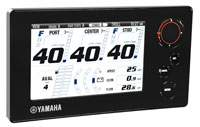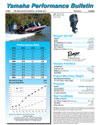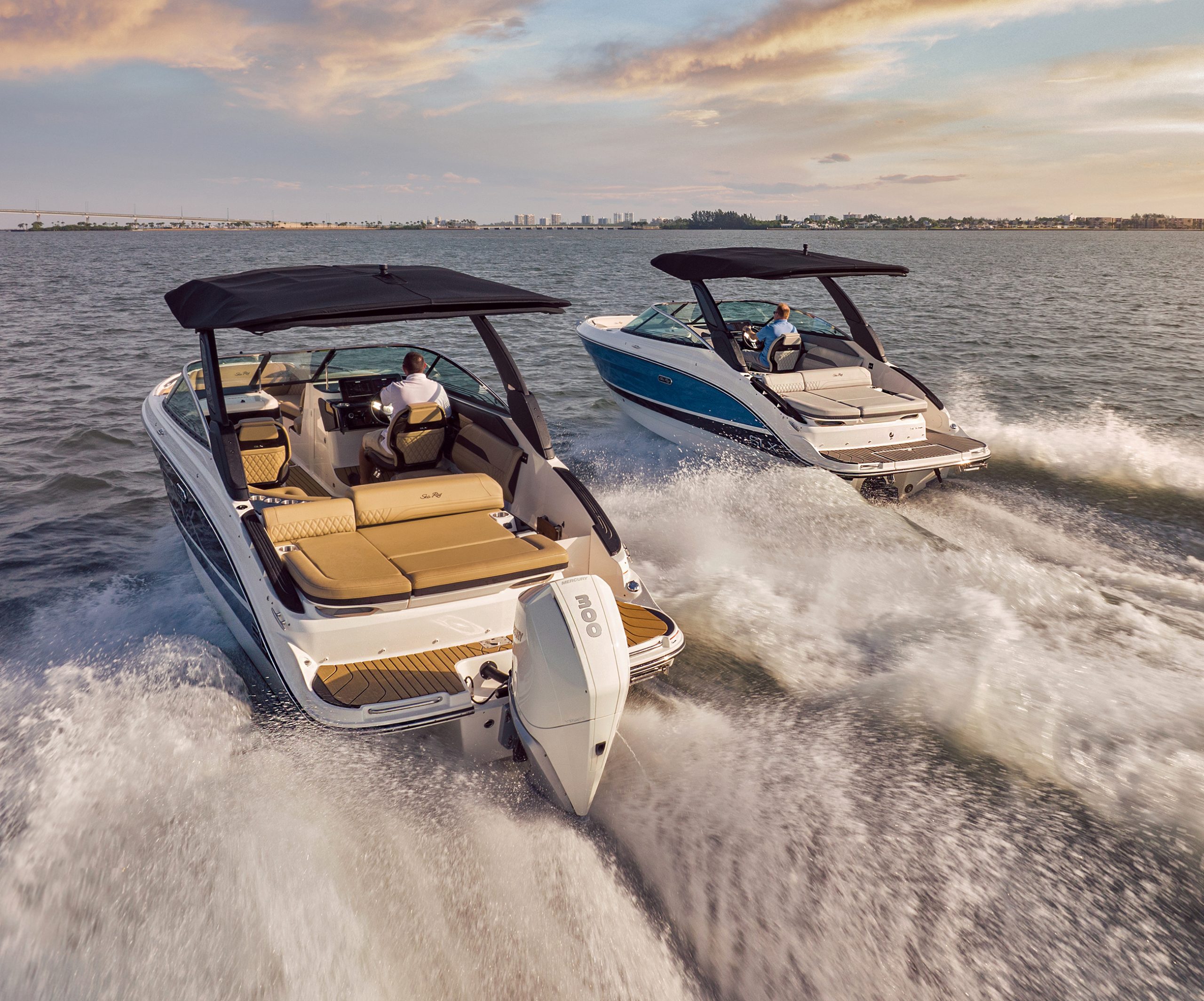The New 4.2-Liter Yamaha Offshore V6
Yamaha's newest outboard provides more displacement and more power, with less weight
I’m sitting here fresh from the Yamaha outboard intro with a mind-boggling pile of notes and spec sheets and technical data about its new 4.2-liter V6 Offshore model, but what matters is this one key fact: Yamaha has produced a big-bore V6 outboard that offers more displacement, yet weighs significantly less, than any four-stroke on the market today. That’s quite an accomplishment.

Less weight on the transom and strong mid-range punch makes the new Yamaha Offshore V6 a good match for fast fishing rigs like this Contender 27 Tournament.
Yamaha will offer the new 4.2-liter Offshore F-series outboards rated at 225, 250 and 300 horsepower. Each has a dry weight (no oil or prop) of 558 pounds with a 25-inch shaft, or 51 pounds less than the previous-generation 3.4-liter Offshore V6 models, and a very significant 246 pounds less than the previous Offshore F300, which used the 5.3-liter V8 powerhead and was simply too heavy for most applications in the 300-hp range. For comparison, the Mercury Verado 300 weighs 635 pounds, and the 4.0-liter Suzuki DF300 weighs 580 pounds. You could still go lighter with a two-stroke, however. The Evinrude E-TEC 300 weighs just 528 pounds and remains the lightest regular-production motor that rating. The Mercury OptiMax 250 weighs just 505 pounds. The weight of the two-strokes also does not include a prop or the oil reservoir and oil.
All New Powerhead

The new 4.2-liter Yamaha Offshore outboards offer 24 percent more displacement than the 3.4-liter V6 models they replace, yet weigh 51 pounds less than the previous Offshore V6.
The 4.2-liter powerhead is all-new but will still be familiar to Yamaha fans. With a 60-degree cylinder angle, double over-head cams, and the exhaust ports facing each other (Yamaha’s “in bank” exhaust arrangement) the basic layout is the same as previous Yamaha V6 four-strokes. Electro-mechanical variable cam timing on the intake side is offered at all three power ratings. It’s the same system previously used on the Offshore 250. That feature combines with a larger, 75mm throttle body and longer, retuned intake runners to significantly boost low-to-mid-range torque, according to Yamaha. Full-throttle rpm range is 5000-6000, with peak power rated at 5500 rpm. The 225 is happy on 87 octane fuel, while the 250 and 300 will make peak power on 89 octane, though they will run on 87.
Perhaps the key technical highlight of the new powerhead is the sleeve-less cylinder design that replaces typical steel liners within each aluminum cylinder bore. An alloy dust of chrome, nickel, manganese and other elements is super-heated in a plasma process and fused to the cylinder. This saves about 6.2 pounds of weight and permits about 2mm more cylinder bore in the same block size. The coating is said to be 60 percent harder than steel and thus very wear resistant. It also offers a “micro-texture” surface (think about the dimples on a golf ball) that holds oil to further reduce wear, aid cooling, and significantly reduce friction, which in turn enhances both power and economy. This texture is really micro. To the naked eye the surface looks smooth as chrome.
Further weight reduction was achieved through careful casting techniques and little things like trimming excess steel from the camshafts and using new plastic cam covers. Overall the 4.2-liter powerhead weighs 17 pounds less than the 3.4-liter V6 it replaces. A new composite lower pan (the bodywork directly below the cowl) replaces the previous aluminum pan and saves 12.7 pounds. The mid-section was re-shaped to cut 11 pounds. The alternator weighs 5.6 pounds less.
Offshore Specific

The new Yamaha Command Link Plus LCD can display data from multiple outboards on a variety of formats.
Available for 25 and 30-inch transoms, the Yamaha Offshore models are offered only with Yamaha Command Link digital controls. A new 70-amp alternator makes a whopping 55 amps at just 1000 rpm to keep the batteries charged during prolonged trolling sessions. Mercury and Suzuki offer 50 and 54 peak amps respectively, and Yamaha says that its new powerhead consumes less current, so there’s more net charging power available for the boat. The gearcase has four cooling water inlets, two low and forward and two more higher and further aft. Each works independently to help insure good water flow in a variety of trim and wake situations. A new rubber compound in the motor mounts is said to better isolate engine vibration from the boat. Yamaha says these new motors are about one inch taller and wider than the previous V6 models.
The Command Link system can be rigged with a variety of instrument displays, from good-old analog to a new Command Link Plus display that has a single, five-inch LCD screen that reports engine and boat data, including four different boat tank levels, for example. Command Link automatically syncs multiple engines, and a variable-speed trolling feature lets the operator adjust engine rpm in 50-rpm increments from 600 to 1000 rpm. There’s also a new Command Link Gateway device that interfaces engine data with any NMEA-2000 display. Command Link control boxes have been undated, and it will be possible to throttle three Offshore motors with a two-lever control box. Yamaha will also offer a panel with a single key switch and individual start/stop buttons for up to three engines. Finally, Command Link now incorporates a new anti-theft feature called Yamaha Customer Outboard Protection (YCOP) that uses a key-fob device to electronically disable each motor. This will be an option, and will include two of the water-proof (but not floating) fobs.
Of course, Yamaha says the new Offshore models plane faster and are more fuel efficient than its competitors in this class. I can’t verify that without conducting head-to-head tests, and we only got to briefly run boats powered by the new motors up and down the Tennessee River in front of the Yamaha Test Center near Bridgeport, Ala. One boat I enjoyed was an Edgewater 318 CC rigged with a pair of the Offshore F300 motors (weight was about 10,000 pounds as tested). In this set-up the motors delivered excellent acceleration and impressive mid-range punch. In my experience, the supercharged Mercury Verado is the benchmark for instant, hold-on-tight throttle response. I’m not sure the new Yamaha is quite there yet, but it would make an interesting comparison. This boat was rigged with Teleflex power steering, which reminded me that the Mercury Verado is also the only big outboard with a built-in power steering system. At wide-open throttle aboard the Edgewater, fuel economy never dropped below 1.1 mpg, or about 53 gph combined. I also ran a Ranger 621VS rigged with a single Offshore F300, which turned this 3,800-pound walleye rig into a real North Woods rocket. It took less than half throttle for the Yamaha to power this boat smartly on plane. There is clearly a lot of low-end torque on tap, a trait that should be appreciated by offshore anglers who need that mid-range power to motor through big swells.
Yamaha did not offer any pricing information at this meeting, and would not let me take any under-cowl photos because the motors we ran were pre-production examples. Maybe Yamaha still has some patents to secure. These motors will soon be in production in Japan, and will begin appearing at dealers in February, just in time for the Miami boat show, where they are certain to draw a crowd.














